Changing Seasons on the Pacific Flyway


The Pacific Flyway is a main flyway for migratory birds that spans about 4,000 miles north-to-south, from Alaska to Patagonia and about 1,000 miles east-to-west. Washington State is one of the ten states included in the Pacific Flyway. Hundreds of migratory bird species and billions of migratory birds travel up and down the Pacific Flyway each year and in Grays Harbor, we are lucky to host many of them.
Along the Pacific Flyway, there are a handful of main “rest stops” where many different species of migratory birds gather each year. One of these key rest stops is in Grays Harbor, at the Grays Harbor National Wildlife Refuge–one of the best places to see migratory shorebirds in North America.
In the spring, Grays Harbor is visited by migratory birds on their northbound journeys. Sandpipers, plovers, and other shorebirds inhabit the wildlife refuge located at Bowerman Basin and other areas in Grays Harbor, like Oyhut Bay and Damon Point. Shorebirds rest along rocky shorelines and on tidal flats, as they fuel up for their journey. In preparation for their trip, shorebirds will increase their body weight exponentially–one species increases the size of its intestine by 100 percent before taking flight.
As shorebirds eat and rest, birds of prey, like Peregrine Falcons, do the same, divebombing the shorebirds. Visit wildlife refuge at Bowerman Basin during spring or fall migration and expect a show!
Compared to spring migration, fall migration is a “drawn out affair,” with some species beginning their southbound migration in late June and others beginning theirs as late as December.
Male hummingbirds are among the first travelers to head south, with females and their fledgling following a couple of weeks after. Enroute to wintering grounds in Mexico, these hummingbirds will be in Arizona by early August.
In August, seabirds, like albatross, can be spotted along shorelines in Grays Harbor, on their migration south.
Waterfowl are the last group to pass through on their fall migration. With an average lifespan of 24 years, Canadian geese make many trips through our region of the Pacific Flyway during their lifetimes. Canadian geese usually visit our section of the Pacific Flyway between September and October before flying in their recognizable ‘V’ formation to southern parts of the U.S.
Many species of waterfowl arrive in our region of the Pacific Flyway in the fall, preparing to spend winter in our relatively mild climate. Dabbling ducks, like mallards, and diving ducks, like the lesser scaups, are prevalent in lakes and wetlands in Grays Harbor. 11 different species of sea ducks inhabit Washington’s beaches in the winter.
Millions of birds pass through Grays Harbor throughout the year. As the seasons change, you can always count on one thing–the Pacific Flyway will be busy!
Sources
“Bird Migration: Birds of the Pacific Flyway, ”Perky Pet. https://www.perkypet.com/articles/pacific-flyway-migration. Accessed 14 August 2022.
“Bowerman Basin,” Birdweb. http://birdweb.org/birdweb/site/bowerman_basin/2. Accessed 14 August 2022.
Handwerk, Brian. “Do Canadian Geese Still Fly South for the Winter?” National Geographic. https://www.nationalgeographic.com/animals/article/do-canada-geese-still-fly-south-for-winter. Accessed 14 August 2022.
Kufman, Kenn. “Fall Migration Hot Spots,” Audubon. https://www.audubon.org/magazine/july-august-2009/fall-migration-hot-spots. Accessed 14 August 2022.
“Must See Migrations,” The Nature Conservancy. https://www.nature.org/en-us/about-us/where-we-work/united-states/washington/stories-in-washington/must-see-migrations/. Accessed 14 August 2022.
Schwartz, Alex. “It’s Fall Migration on the Pacific Flyway,” Klamath Falls Herald and News. Accessed 14 August 2022.
“Waterfowl of Washington.” Washington Department of Fish and Wildlife. https://wdfw.medium.com/waterfowl-of-washington-acc5337c5f3c. Accessed 14 August 2022.
White, Mel. “Birding in Washington State,” Audubon. https://www.audubon.org/news/birding-washington. Accessed 14 August 2022.
© Holly Duffy, August 2022
Touch whale bones, examine shipwreck artifacts and connect with the coast's living history.

Support our mission, get involved in educational programs, or contribute through donations and volunteering.